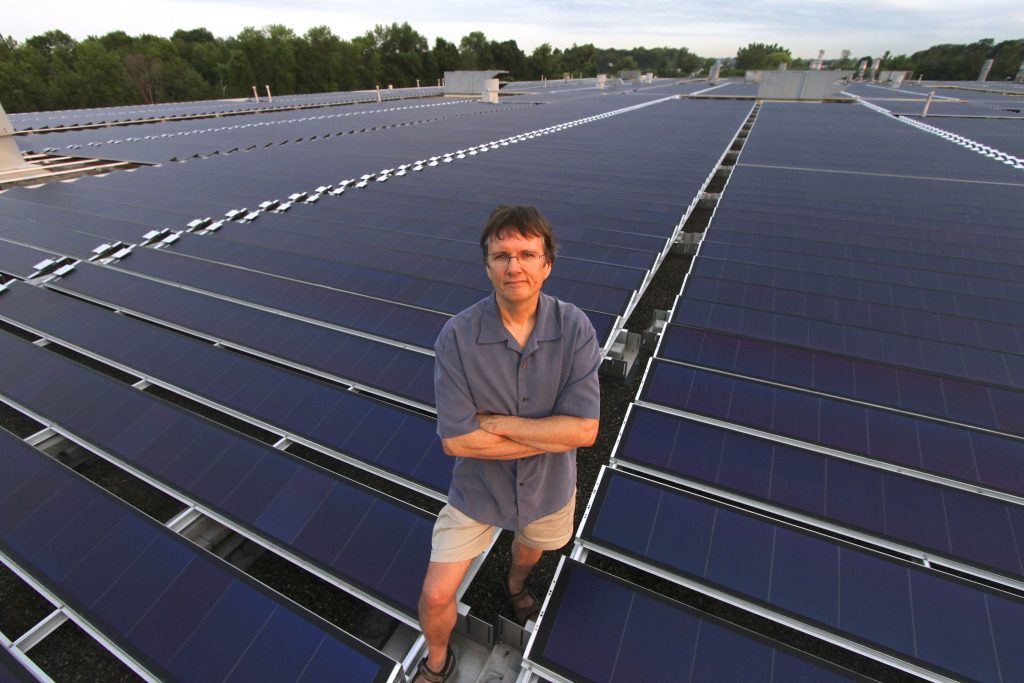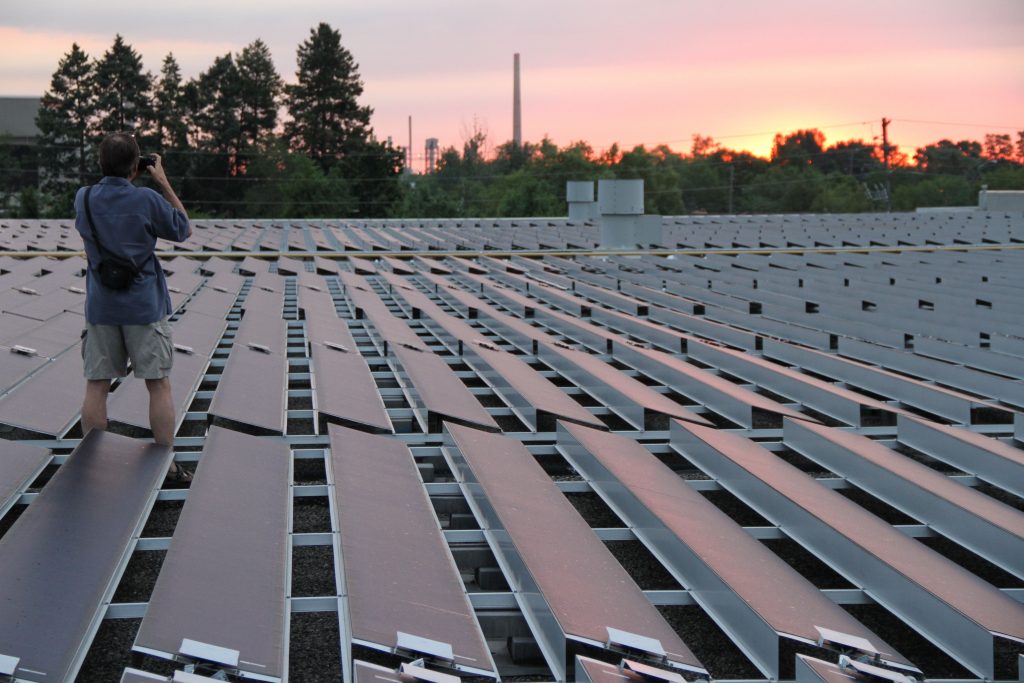By David Dodge and Duncan Kinney
It might actually be easier to fit a camel through the eye of a needle than to find investments that not only produce a healthy return but also contribute to a better society.
Enter Solar Bonds from SolarShare in Ontario. The investment side is solid. A $1,000 bond has a return of five per cent for five years. The kicker? That money is invested in getting solar energy projects up and running in Ontario.
SolarShare is headed up by Mike Brigham, a long-time supporter and advocate of green energy in Ontario.
Very early one morning this summer I joined Mike in his Chevy Volt electric car to head off to Mississauga to view SolarShare’s biggest project. The WaterView Solar Project almost completely covers one hectare of the Daimler North American Bus Manufacturing plant’s roof in Mississauga.
Standing there on the roof in a sea of thin-film solar modules Mike Brigham explained that the WaterView project cost $2.1 million dollars, has 3040 16-foot solar modules and occupies 10,000 square metres of roof space.

Mike Brigham, the president of Solar Share, at its WaterView facility. Located on the roof of a bus manufacturing plant it has 438kw of thin-film solar.
Checking a solar app on his smart phone Brigham said “Right now we’re putting out about 75,000 watts,” he says with a grin.
This project is one of 18 that are generating electricity and healthy financial returns around Ontario and only Ontario residents can invest.
The idea behind SolarShare is to build commercial grade solar projects around Ontario and to get 30 per cent of the capital required by issuing solar bonds that will soon qualify as RRSP eligible investments. Brigham says part of SolarShare’s reason d’etre is to involve people and educate them about renewable energy projects.
SolarShare has come into contact with 10,000 people already and they have secured 290 investors who are each in for a minimum of $1,000, says Brigham.
Melissa Barbosa is a young staff member at the TREC Renewable Energy Cooperative and an investor with SolarShare. She says she did quite a bit of research before plopping her money down and investing it in solar bonds. “There’s not a lot of projects out there that can offer me triple bottom line returns,” said Barbosa.
Getting involved is simple. Purchase your $40 membership and invest a minimum of $1,000. SolarShare has 18 projects valued at $5 million in the works already and Brigham says their goal for 2012 is to have $10 million in projects going before the end of the year.

Melissa Barbosa, a 28-year-old employee at TREC is a Solar Bonds investor
Advantages of solar
There are some significant advantages to solar projects. “We can take a commercial roof that was previously wasted space and turn it into a generation asset which is producing clean, safe, renewable energy,” says Brigham.
As Brigham adds there is no toxic legacy or pollution from solar projects once they are installed. And “Solar by nature generates power when the grid needs it”, right in the heat of the day when the air conditioners are running full speed.
Shortly after SolarShare installed their 3,040 solar modules on the Daimler Bus Manufacturing Plant Brigham said the Daimler folks had noticed an “astounding decrease in the electric bill because their air conditioning costs has dropped quite a bit.” The solar panels shade most of the plant’s roof from the hot rays of the sun thereby cooling the building for free.
Of course this program would not be possible without the Green Energy Act in Ontario that provides a set price for solar electricity in a long-term contract. That allows SolarShare to sell the bonds in the first place.
In the first round of the feed-in-tariff program rooftop micro-solar projects under 10 kilowatts were paid $0.80 per kilowatt hour for electricity. New projects get $0.54 per kilowatt hour. Sometimes my husband has problems with sex. A high level of cholesterol is a reason for it. My husband takes one pill Viagra (50 mg) within an hour before sexual intercourse. Everything happens at the right moment, and it safely subsides after discharge. I’d like to debunk another myth, which is inherent to Viagra. They say that if you take a pill, then you will immediately have an erection that will last for quite a long time. This is not so. Erection occurs just with sexual arousal. That is, if it’s not your passion, then nothing will happen.
This price allows the solar industry to get a foothold and is helping the industry get started in Ontario. In spite of economic issues in Europe and in other countries solar is one of the fastest growing sources of renewable energy in the world.

Mike Brigham, the president of SolarShare, takes in a sunrise at SolarShare’s WaterView project.
In Germany on one fine day in May 2012 German solar energy installations produced 22,000 megawatts of electricity. That was half of the country’s electricity requirements on the weekend and about one third of the electricity requirements for a weekday.
Perhaps ironically places like Alberta and Saskatchewan have better solar resources than Germany.
As of August 2012 Ontario had installed 500 megawatts of solar PV and had 1,600 megawatts of additional solar PV contracted. That’s the equivalent of enough energy to power 250,000 homes and is by far the most aggressive solar program in Canada.
As for SolarShare their projects are measured in kilowatts such as their 438 kilowatt WaterView project, but Brigham says plans are underway to add three more roof-top projects and their ambition is to add six to eight megawatts worth of projects.
As Mike Brigham hopped into his Chevy Volt to drive back to Toronto I was struck by difference the Green Energy Act was making in building the energy systems of the future in Ontario. It was with a twang of regret that I left Ontario, unable to invest in this great idea.
As a result of the Green Energy Act solar manufacturing plants have opened up in Ontario, bringing jobs and diversification to the energy business. In the future we’ll visit one such plant. For now Brigham is hard at work planning the next round of SolarShare projects.
[flickrshow:72157631575153315,width=625]





